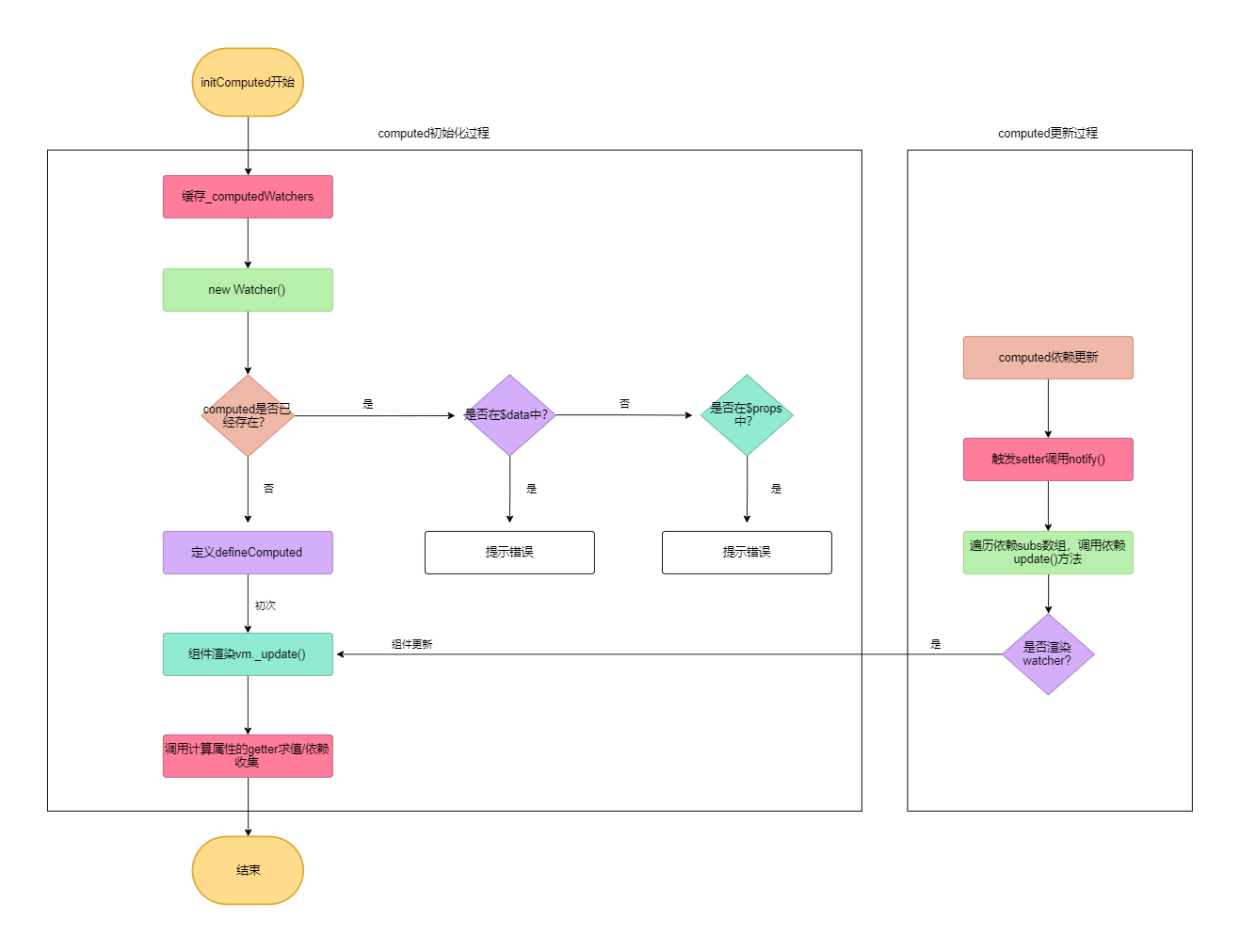computed处理
处理computed相关的逻辑,发生在initState中,接下来我们详细分析与computed相关的逻辑。
export function initState (vm: Component) {
// 省略代码
const opts = vm.$options
if (opts.computed) initComputed(vm, opts.computed)
}
我们知道computed计算属性是依赖于其它响应式变量的,因此我们分析computed的时候会分为两个步骤:computed初始化和computed更新。
computed初始化
在initState()方法中如果我们传递了computed,那么会调用initComputed()方法。initComputed()方法定义在src/core/instance/state.js文件中,其代码如下:
const computedWatcherOptions = { lazy: true }
function initComputed (vm: Component, computed: Object) {
// $flow-disable-line
const watchers = vm._computedWatchers = Object.create(null)
// computed properties are just getters during SSR
const isSSR = isServerRendering()
for (const key in computed) {
const userDef = computed[key]
const getter = typeof userDef === 'function' ? userDef : userDef.get
if (process.env.NODE_ENV !== 'production' && getter == null) {
warn(
`Getter is missing for computed property "${key}".`,
vm
)
}
if (!isSSR) {
// create internal watcher for the computed property.
watchers[key] = new Watcher(
vm,
getter || noop,
noop,
computedWatcherOptions
)
}
// component-defined computed properties are already defined on the
// component prototype. We only need to define computed properties defined
// at instantiation here.
if (!(key in vm)) {
defineComputed(vm, key, userDef)
} else if (process.env.NODE_ENV !== 'production') {
if (key in vm.$data) {
warn(`The computed property "${key}" is already defined in data.`, vm)
} else if (vm.$options.props && key in vm.$options.props) {
warn(`The computed property "${key}" is already defined as a prop.`, vm)
}
}
}
}
代码分析:
- 在
initComputed()方法中,首先定义了一个_computedWatchers的变量,这个变量的作用是缓存当前实例所有计算属性的watcher。 - 接下来遍历所有的
computed,然后对每一个computed进行类型判断,如果是function类型,那么直接使用,如果是对象则代表是get/set形式,则直接取get。如果最后获取到的computed的getter为null,则在开发环境下提示错误。
// 两种类型的计算属性
export default {
props: ['index'],
data () {
return {
firstName: 'first',
lastName: 'last'
}
},
computed: {
fullName () {
return this.firstName + this.lastName
},
active: {
get: function () {
return this.index
},
set: function (newVal) {
this.$emit('update:index', newVal)
}
}
}
}
以上面代码为例,两种类型的computed获取到的getter分别如下:
// function类型
const getter = function () {
this.firstName + this.lastName
}
// get/set类型
const getter = function () {
return this.index
}
- 然后在非
SSR服务端渲染的情况下,会在_computedWatchers上新建一个Watcher的实例。以上面代码为例,_computedWatchers在遍历完毕后,可以用如下代码表示:
// 当前vm实例
{
_computedWatchers: {
fullName: new Watcher(),
active: new Watcher()
}
}
- 最后、首先判断了当前遍历的
computed是否已经在vm实例上,如果不在则调用defineComputed()方法,如果在还需要判断当前遍历的computed是否和props、data命名冲突,如果冲突则提示错误。
注意:对于子组件而言,这个时候当前遍历的computed已经在vm实例上了,所以并不会调用defineComputed()方法,我们从上面代码注释也能看的出来。对于子组件而言,真正initComputed的过程是发生在Vue.extend方法中:
Vue.extend = function (extendOptions) {
// 省略代码
const Super = this
const Sub = function VueComponent (options) {
this._init(options)
}
Sub.prototype = Object.create(Super.prototype)
Sub.prototype.constructor = Sub
// 初始化子组件的computed
if (Sub.options.computed) {
initComputed(Sub)
}
}
// extend.js中的initComputed定义
function initComputed (Comp) {
const computed = Comp.options.computed
for (const key in computed) {
defineComputed(Comp.prototype, key, computed[key])
}
}
然后initComputed调用的defineComputed()方法,就和我们现在的defineComputed()方法是同一个方法,它和此时的initComputed()方法定义在同一个位置(src/core/instance/state.js):
const sharedPropertyDefinition = {
enumerable: true,
configurable: true,
get: noop,
set: noop
}
export function defineComputed (
target: any,
key: string,
userDef: Object | Function
) {
const shouldCache = !isServerRendering()
if (typeof userDef === 'function') {
sharedPropertyDefinition.get = shouldCache
? createComputedGetter(key)
: createGetterInvoker(userDef)
sharedPropertyDefinition.set = noop
} else {
sharedPropertyDefinition.get = userDef.get
? shouldCache && userDef.cache !== false
? createComputedGetter(key)
: createGetterInvoker(userDef.get)
: noop
sharedPropertyDefinition.set = userDef.set || noop
}
if (process.env.NODE_ENV !== 'production' &&
sharedPropertyDefinition.set === noop) {
sharedPropertyDefinition.set = function () {
warn(
`Computed property "${key}" was assigned to but it has no setter.`,
this
)
}
}
Object.defineProperty(target, key, sharedPropertyDefinition)
}
defineComputed()方法的逻辑很简单,根据不同的类型的computed,对sharedPropertyDefinition的get和set进行赋值。sharedPropertyDefinition在之前的proxy中,我们已经介绍过, 它就是Object.defineProperty()方法descriptor参数的一个共享配置。
在非SSR服务端渲染的情况,sharedPropertyDefinition.get的值是调用了createComputedGetter()方法,而在SSR服务端渲染的情况下是调用了createGetterInvoker()方法。我们在分析Vue源码的过程中,因为侧重于Web浏览器端的表现,因此我们接下来会分析createComputedGetter()方法的实现。createComputedGetter()方法和defineComputed()方法定义在同一个位置,代码如下:
function createComputedGetter (key) {
return function computedGetter () {
const watcher = this._computedWatchers && this._computedWatchers[key]
if (watcher) {
if (watcher.dirty) {
watcher.evaluate()
}
if (Dep.target) {
watcher.depend()
}
return watcher.value
}
}
}
我们可以看到createComputedGetter()方法返回了一个函数,这个函数会在获取computed的时候被调用,例如组件渲染的时候:
<template>
<div>{{fullName}}</div>
</template>
根据以上代码我们再来看computedGetter()方法:组件渲染的时候会获取fullName计算属性,然后调用computedGetter()方法,在这个方法执行的时候,首先判断watcher.dirty属性,这个属性在new Watcher()的时候与我们传入的const computedWatcherOptions = { lazy: true }有关。在Watcher类的构造函数中,有这样一段代码:
class Watcher {
// 省略代码
constructor (vm, expOrFn, cb, options, isRenderWatcher) {
if (options) {
this.lazy = !!options.lazy
} else {
this.lazy = false
}
this.dirty = this.lazy
}
}
因为我们传入的lazy值为true,因此watcher.dirty条件判断为真,进行watcher.evaluate()计算。随后判断了Dep.target为真,则进行依赖收集watcher.depend(),关于依赖收集我们会在之后的章节详细介绍。我们只要知道,当在组件渲染的时候触发的computed依赖收集,收集的是render watcher。最后,我们看一下watcher.evaluate()方法的实现:
class Watcher {
/**
* Evaluate the value of the watcher.
* This only gets called for lazy watchers.
*/
evaluate () {
this.value = this.get()
this.dirty = false
}
}
evaluate()方法它的实现非常简单,就是触发computed的getter进行求值,然后把dirty设置为false。
computed更新
在介绍完了computed的初始化后,我们在来看computed的更新过程,以下面例子为例:
export default {
template: `
<div>{{fullName}}</div>
<button @click="change">change</button>
`
data () {
return {
total: 0,
firstName: 'first',
lastName: 'last'
}
},
computed: {
fullName () {
if (this.total > 0) {
return this.firstName + this.lastName
} else {
return 'pleace click'
}
}
},
methods: {
change () {
this.total++
}
}
}
因为total、firstName和lastName全部为响应式变量,所以fullName这个计算属性初始化的时候,此时total值为0,fullName计算属性有两个Watcher,其中一个是计算属性watcher,另外一个是渲染watcher。当点击按钮触发事件后,会触发total属性的setter方法,进而调用一个叫做notify的方法。
set: function reactiveSetter (newVal) {
// 省略
dep.notify()
}
其中notify()是定义在Dep类中的一个方法:
export default class Dep {
constructor () {
this.subs = []
}
notify () {
// stabilize the subscriber list first
const subs = this.subs.slice()
if (process.env.NODE_ENV !== 'production' && !config.async) {
// subs aren't sorted in scheduler if not running async
// we need to sort them now to make sure they fire in correct
// order
subs.sort((a, b) => a.id - b.id)
}
for (let i = 0, l = subs.length; i < l; i++) {
subs[i].update()
}
}
}
代码分析:
subs就是我们收集起来的watcher,它是一个数组,对应上面案例的话它是一个长度为2的数组并且其中一个元素为render watcher,另一个元素为computed watcher。- 在
notify()方法调用时,会遍历subs数组,然后依次调用当前watcher的update方法。其中update方法是定义在Watcher类中的一个实例方法,代码如下:
class Watcher {
// 省略其它
update () {
/* istanbul ignore else */
if (this.lazy) {
this.dirty = true
} else if (this.sync) {
this.run()
} else {
queueWatcher(this)
}
}
}
当第一次遍历时,此时的watcher为计算属性watcher,我们已经在前面介绍过计算属性watcher它的this.lazy值为true,因此会进行this.dirty = true。
当第二次遍历时,此时的watcher为渲染watcher,对于渲染watcher而言,它的lazy值为false,this.sync为false,因此会调用queueWatcher()方法。我们目前不需要知道queueWatcher是怎么实现的,只需要知道queueWatcher()方法在调用时,会触发updateComponent()方法:
updateComponent = () => {
vm._update(vm._render(), hydrating)
}
我们可以看到updateComponent()方法调用了vm._update方法,而这个方法的作用就是重新进行组件渲染,在组件渲染的过程中,会再次读取fullName的值,也就是说会调用下面这段代码:
fullName () {
if (this.total > 0) {
return this.firstName + this.lastName
} else {
return 'pleace click'
}
}
因为此时的total值为1,所以会返回this.firstName + this.lastName的值,而firstName和lastName又是定义在data中的响应式变量,会依次触发firstName和lastName的getter,然后进行依赖收集。在组件渲染完毕后,fullName的依赖数组subs此时会有四个watcher,分别是三个计算属性watcher和一个渲染watcher。无论这三个计算属性watcher哪一个值更新了,都会再次重复以上的流程,这就是computed更新的过程。
在分析完computed的相关流程后,我们可以得到如下流程图
